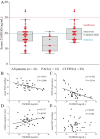Therapeutic impact of dietary vitamin D supplementation for preventing right ventricular remodeling and improving survival in pulmonary hypertension
- PMID: 28686688
- PMCID: PMC5501558
- DOI: 10.1371/journal.pone.0180615
Therapeutic impact of dietary vitamin D supplementation for preventing right ventricular remodeling and improving survival in pulmonary hypertension
Abstract
Background: Pulmonary hypertension (PH), caused by elevated pulmonary vascular resistance, leads to right heart failure and ultimately death. Vitamin D deficiency can predispose individuals to hypertension and left ventricular dysfunction; however, it remains unknown how serum vitamin D level is related to PH and right ventricular (RV) dysfunction.
Methods: Serum 25-hydroxyvitamin D [25(OH)D] levels were assessed in PH patients for an association with disease severity. To examine whether vitamin D supplementation could prevent the development of pulmonary vascular remodeling and RV dysfunction in PH, a rat model of PH was fed either normal chow or a high vitamin D diet.
Results: The majority (95.1%) of PH patients had 25(OH)D levels in the insufficiency range, which is associated with increased mean pulmonary artery pressure, increased pulmonary vascular resistance, and decreased cardiac output in PH patients. Vitamin D supplementation significantly increased serum 25(OH)D levels and improved survival in PH rats. Interestingly, while the supplemented rats retained the typical increases in medial thickness of the muscular pulmonary arteries and RV systolic pressure, RV cardiomyocyte hypertrophy and B-type natriuretic peptide expression was significantly attenuated.
Conclusions: Vitamin D deficiency is frequently seen in patients diagnosed with PH and low serum levels of 25(OH)D are associated with severity of PH and RV dysfunction. Vitamin D supplementation in PH rats improved survival via ameliorating pathological RV hypertrophy. These findings suggest an insufficient intake of vitamin D might potentially accelerate RV dysfunction, leading to a crucial clinical impact of vitamin D supplementation in PH.
Conflict of interest statement
Figures






References
-
- Pulido T, Adzerikho I, Channick RN, Delcroix M, Galiè N, Ghofrani HA, et al. Macitentan and morbidity and mortality in pulmonary arterial hypertension. N Engl J Med. 2013;369:809–18. doi: 10.1056/NEJMoa1213917 - DOI - PubMed
-
- Sitbon O, Channick R, Chin KM, Frey A, Gaine S, Galiè N, et al. Selexipag for the treatment of pulmonary arterial hypertension. N Engl J Med. 2015;373:2522–33. doi: 10.1056/NEJMoa1503184 - DOI - PubMed
-
- Farber HW, Miller DP, Poms AD, Badesch DB, Frost AE, Muros-Le Rouzic E, et al. Chest. 2015;148:1043–54. doi: 10.1378/chest.15-0300 - DOI - PubMed
-
- Delcroix M, Lang I, Pepke-Zaba J, Jansa P, D'Armini AM, Snijder R, et al. Long-term outcome of patients with chronic thromboembolic pulmonary hypertension: results from an international prospective registry. Circulation. 2016;133:859–71. doi: 10.1161/CIRCULATIONAHA.115.016522 - DOI - PubMed
-
- Holick MF. Vitamin D deficiency. N Engl J Med. 2007;357:266–81. doi: 10.1056/NEJMra070553 - DOI - PubMed
MeSH terms
Substances
LinkOut - more resources
Full Text Sources
Other Literature Sources
Medical

